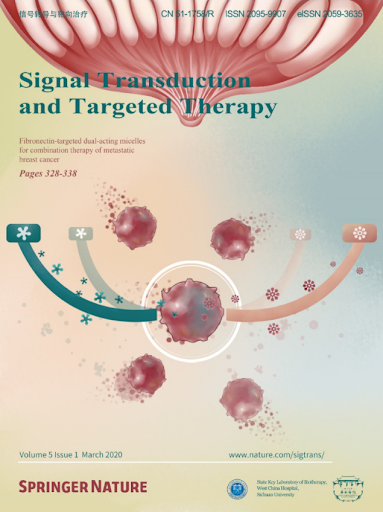一种富含亮氨酸重复序列的蛋白15靶向放射免疫治疗方法的发展,以消除促肿瘤机制和免疫治疗耐药性。
IF 52.7
1区 医学
Q1 BIOCHEMISTRY & MOLECULAR BIOLOGY
引用次数: 0
摘要
富含亮氨酸的重复序列15 (Leucine-rich repeat containing 15, LRRC15)已成为一种有吸引力的生物标志物和癌症治疗靶点。转化生长因子-β (tgf -β)在侵袭性和治疗抵抗性肿瘤细胞中特异性诱导这种质膜蛋白的表达,而在非肿瘤组织中很少表达。我们开发了一种人源化单克隆抗体DUNP19,它能以高亲和力特异性结合系统发育保守的LRRC15表位,并在LRRC15结合后迅速内化。在多种皮下和原位肿瘤移植小鼠模型中,镥-177标记的DUNP19 ([177Lu]Lu-DUNP19)能够对表达lrrc15的癌细胞和小鼠癌症相关成纤维细胞进行无创成像和分子精确放疗,以最小的毒性有效地阻止肿瘤进展并延长生存期。[177Lu] lu - dunp19治疗肿瘤的转录组学分析揭示了促肿瘤机制的缺失,包括先前报道的tgf β诱导的与免疫治疗耐药相关的LRRC15+特征。在同基因肿瘤模型中,给药[177Lu]Lu-DUNP19可显著增强检查点阻断治疗,产生持久的完全缓解。总之,这些结果表明,用DUNP19靶向LRRC15的放射治疗是一个令人信服的精准医学平台,可用于图像引导诊断、根除和重编程LRRC15+肿瘤组织,在广泛的目前无法治疗的恶性肿瘤中驱动免疫抵抗和疾病侵袭性。本文章由计算机程序翻译,如有差异,请以英文原文为准。
Development of a leucine-rich repeat-containing protein 15-targeted radio-immunotheranostic approach to deplete pro-tumorigenic mechanisms and immunotherapy resistance.
Leucine-rich repeat containing 15 (LRRC15) has emerged as an attractive biomarker and target for cancer therapy. Transforming growth factor-β (TGFβ) induces the expression of this plasma membrane protein specifically in aggressive and treatment resistant tumor cells derived from mesenchymal stem cells, with minimal expression observed in non-neoplastic tissues. We have developed a humanized monoclonal antibody, DUNP19, that specifically binds with high affinity to a phylogenetically conserved LRRC15 epitope and is rapidly internalized upon LRRC15 binding. In multiple subcutaneous and orthotopic tumor xenograft mouse models, Lutetium-177 labeled DUNP19 ([177Lu]Lu-DUNP19) enabled non-invasive imaging and molecularly precise radiotherapy to LRRC15-expressing cancer cells and murine cancer-associated fibroblasts, effectively halting tumor progression and prolonging survival with minimal toxicity. Transcriptomic analyses of [177Lu]Lu-DUNP19-treated tumors reveal a loss of pro-tumorigenic mechanisms, including a previously reported TGFβ-induced LRRC15+ signature associated with immunotherapy resistance. In a syngeneic tumor model, administration of [177Lu]Lu-DUNP19 significantly potentiated checkpoint-blockade therapy, yielding durable complete responses. Together, these results demonstrate that radio-theranostic targeting of LRRC15 with DUNP19 is a compelling precision medicine platform for image-guided diagnosis, eradication, and reprogramming of LRRC15+ tumor tissue that drives immuno-resistance and disease aggressiveness in a wide range of currently untreatable malignancies.
求助全文
通过发布文献求助,成功后即可免费获取论文全文。
去求助
来源期刊

Signal Transduction and Targeted Therapy
Biochemistry, Genetics and Molecular Biology-Genetics
CiteScore
44.50
自引率
1.50%
发文量
384
审稿时长
5 weeks
期刊介绍:
Signal Transduction and Targeted Therapy is an open access journal that focuses on timely publication of cutting-edge discoveries and advancements in basic science and clinical research related to signal transduction and targeted therapy.
Scope: The journal covers research on major human diseases, including, but not limited to:
Cancer,Cardiovascular diseases,Autoimmune diseases,Nervous system diseases.
 求助内容:
求助内容: 应助结果提醒方式:
应助结果提醒方式:


